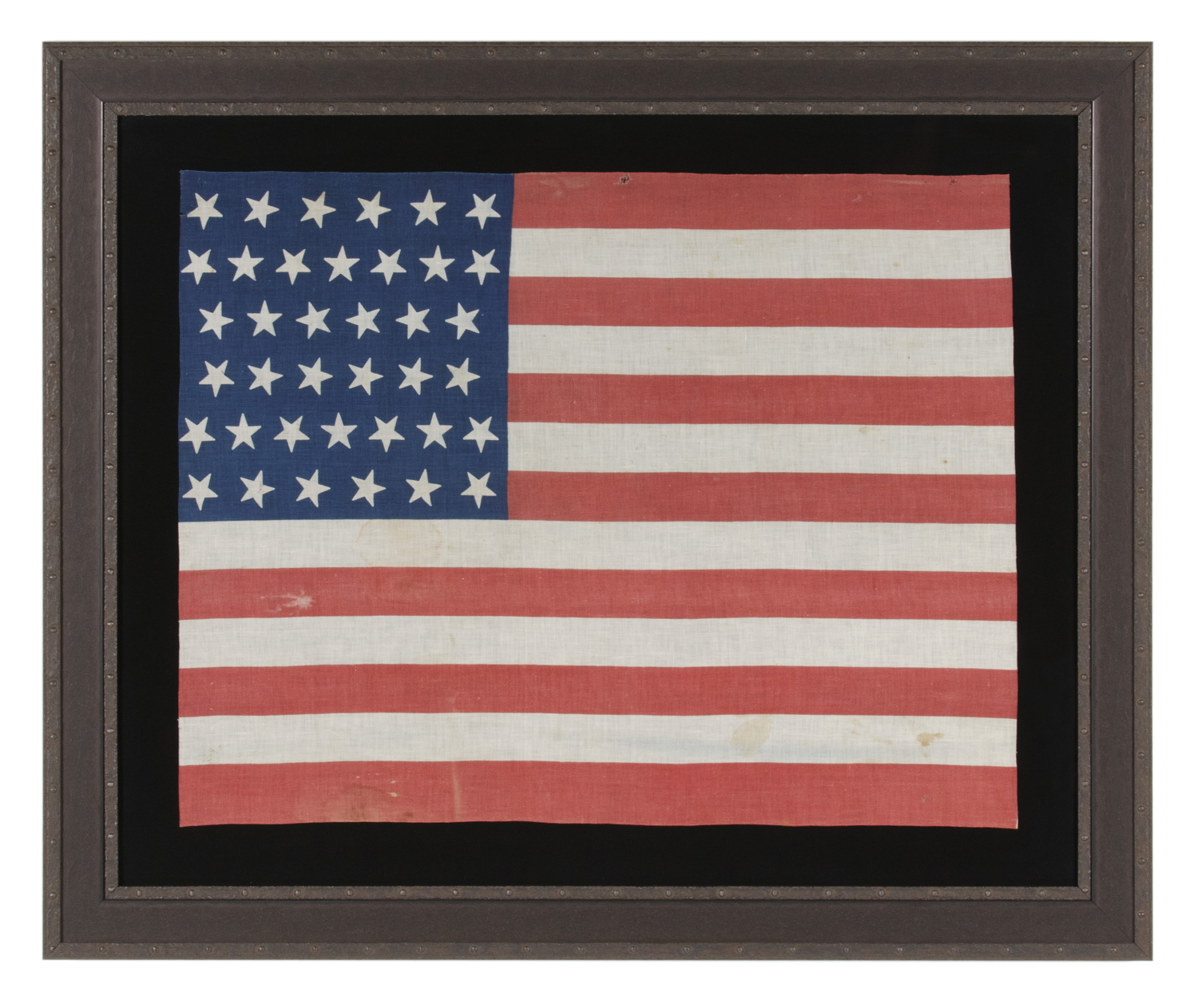
| |
38 STARS WITH VARYING ORIENTATIONS ON AN ANTIQUE AMERICAN FLAG WITH "SQUARISH" PROPORTIONS, A LARGE AND EXTREMELY SCARCE EXAMPLE, 1876-1889, COLORADO STATEHOOD |
|
| Available: |
Sold |
| Frame Size (H x L): |
35.5" x 42.75" |
| Flag Size (H x L): |
25.25" x 32" |
|
| Description....: |
|
38 STARS WITH VARYING ORIENTATIONS ON AN ANTIQUE AMERICAN FLAG WITH "SQUARISH" PROPORTIONS, A LARGE AND EXTREMELY SCARCE EXAMPLE, 1876-1889, COLORADO STATEHOOD:
38 star American parade flag, printed on plain weave cotton. The stars are arranged in lineal rows of 6-7-6-6-7-6, but have several unusual features. When flags have stars in different numbers in consecutive rows, typically the rows are either justified, so each is the same length, or the rows are staggered back-and-forth in some sort of logical fashion. In this case, note how the first and second rows have different counts but are of equal length. That is not unusual and appears to be the start of a justified pattern. Although they have the same count as the first row, the middle two rows are shorter, while the remaining two rows are a mirror image of those at the top in terms of their spacing. This results in an arrangement that has sort-of an hourglass formation. Hourglass patterns appear in other flags, but in all other cases that I can recall the layout is created with rows that are naturally bigger and smaller because they have more or less stars than those around them.
Another peculiarity lies in the orientation of the stars on their vertical axis. Here again, usually the position follows some sort of logical progression throughout. Even if the positioning is random, it is predictably so throughout. In this case, the first star in the first row is upside-down (with two points up instead of one). The next three stars are canted to the right, with one point directed in the 1:00 position. The next star is right-side-up and the last is upside-down. In the next row, the stars are in what I call a "dancing" or "tumbling" formation, alternating from point-up to point-down throughout. The next row has one star canted in the 1:00 position, followed by one that is right-side-up, followed by 4 stars canted in the 11:00 position. The last row has one star upside-down, followed by 4 canted toward 1:00, and ending in another upside-down star.
This is a very peculiar arrangement and is attractive because of the amount of movement the hourglass and the unusual star orientation both lend to the overall presentation.
Three other characteristics are also of interest. One is the square format of the blue canton and another is the somewhat square proportions of the flag itself. Also note how the width of the last stripe is wider than the rest. This is due to how the design was laid out on the bolt of fabric. Flag collectors appreciate these sort of features, which make early flags different than what one would expect today.
Colorado became the 38th state on August 1st, 1876. This was the year of our nation’s centennial of independence from Great Britain. Although 37 was the official star count for the American flag in 1876, flag-making was a competitive venture, and no one wanted to be making 37 star flags when others were making 38’s. It is for this reason that 38 and 13 stars (to represent the original 13 colonies) are the two star counts most often seen at the Centennial International Exposition, the six-month long, World’s Fair event, held in honor of the anniversary, in Philadelphia. Some flag-makers were actually producing 39 star flags, in hopeful anticipation of the addition of another Western Territory. The 38 star flag became official on July 4th, 1877 and was generally used until the addition of the Dakotas in 1889.
Mounting: The flag has been hand-stitched to a background of 100% cotton, black in color, which was washed to reduce excess dye. An acid-free agent was added to the wash to further set the dye and the fabric was heat-treated for the same purpose. The mount was then placed in a 3-part frame that is constructed of wood but has a beautiful metallic finish that presents like gunmetal and rusted antique iron. The glazing is U.V. protective acrylic.
Condition: There are a couple of minor tack holes along the top stripe. There is very minor foxing and staining throughout and there is moderate overall fading of the red stripes. There are minor to moderate bleached areas in the last three stripes in the hoist-end quadrant of the flag. Many of my clients prefer early flags to show their age and evidence of use. |
|
|
|
| Collector Level: |
Intermediate-Level Collectors and Special Gifts |
|
| Flag Type: |
Parade flag |
|
| Star Count: |
38 |
|
| Earliest Date of Origin: |
1876 |
|
| Latest Date of Origin: |
1889 |
|
| State/Affiliation: |
Colorado |
|
| War Association: |
1866-1890 Indian Wars |
|
| Price: |
SOLD |
|
| |
Views: 3284 |
|
|
|

